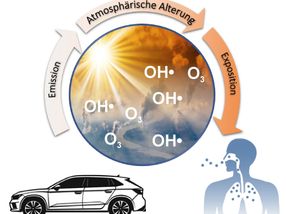Low-cost material for lighting and diagnostics produces white light imitating sunlight
Researchers at the University of Turku, Finland, have developed a synthetic material based on the natural hackmanite mineral which produces broad spectrum white light in lamps. The hackmanite created by the Inorganic materials chemistry research group is a low-cost material emitting luminescence closer to sunlight than that of the currently used lanthanides.

Ana_J; pixabay.com; CC0
The hackmanite developed by the research group contains only highly abundant and non-toxic elements. Therefore, hackmanite has low production costs and does not produce hazardous waste or contain health risks.
The lower cost of the material is also a great asset in applications for diagnostics, as the lanthanides that are currently in use are expensive. Because of its persistent luminescence, hackmanite does not require expensive time-resolved spectrometers to measure luminescence, says Docent Mika Lastusaari from the University of Turku.
He believes that hackmanite can also have applications in point-of-care diagnostics because it is excitable with sunlight.
Lamps that produce white light imitating sunlight are used in lighting applications. At the moment, fluorescent lamps and LEDs produce white light with luminescent materials that contain lanthanides.
However, the use of lanthanides is problematic. On the one hand, they are expensive and their price can vary a great deal and, on the other, they do not produce the same broad spectrum that comes from the Sun. White light is produced with lanthanides by mixing three narrow spectrum primary colours, i.e. red, green and blue, and therefore things look different in their light than in the sunshine.
Hackmanite Produces Effective Afterglow
Persistent luminescence, also known as afterglow, is used in applications that glow in the dark, such as exit signs and watches. Our hackmanite material can produce observable white persistent luminescence for seven hours in the dark. With a spectrometer, the luminescence can be detected for more than 100 hours.
Until now, there have been no materials that produce good white persistent luminescence.
The hackmanite we have developed can be used in ordinary lamps as a single component phosphor to produce natural white light. As a bonus, hackmanite lamps continue to glow even after a power failure, thus being suitable for exit and emergency signs.
Hackmanite materials have excellent stability in water and the research group has shown that it has easily detectable photoluminescence even in nanomolar concentrations.
We have also tested the material's application in diagnostics: we demonstrated that the material's persistent luminescence can be used in authenticating spices and testing for counterfeit foods. The tests were conducted together with the Detection Technology Group of the Department of Chemistry.
Original publication
See the theme worlds for related content
Topic world Diagnostics
Diagnostics is at the heart of modern medicine and forms a crucial interface between research and patient care in the biotech and pharmaceutical industries. It not only enables early detection and monitoring of disease, but also plays a central role in individualized medicine by enabling targeted therapies based on an individual's genetic and molecular signature.

Topic world Diagnostics
Diagnostics is at the heart of modern medicine and forms a crucial interface between research and patient care in the biotech and pharmaceutical industries. It not only enables early detection and monitoring of disease, but also plays a central role in individualized medicine by enabling targeted therapies based on an individual's genetic and molecular signature.

























































